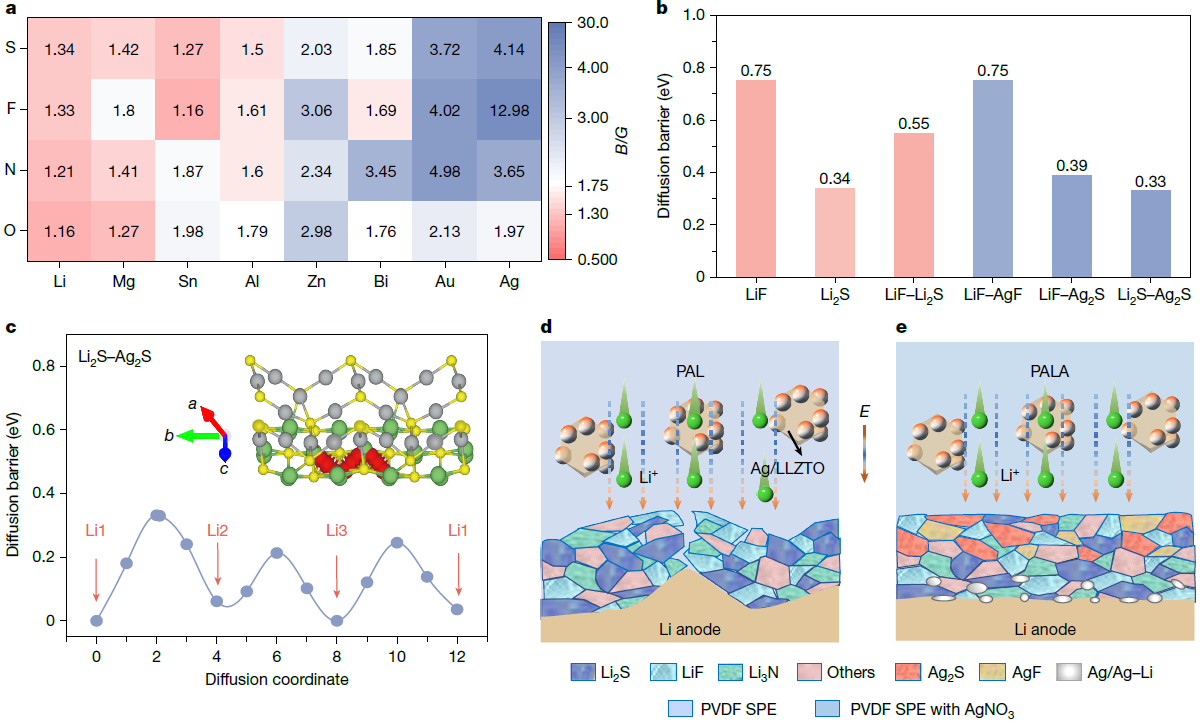Chinese Researchers Make Progress in Solid-State Battery
Supported by projects from the National Natural Science Foundation of China (Grant Nos. 52325206, U2001220, 92470110), Professor Feiyu Kang, Professor Yanbing He from the Shenzhen International Graduate School of Tsinghua University, in collaboration with Professor Quanhong Yang from Tianjin University, have achieved a new progress in the field of solid-state batteries. The related research findings were published in Nature on October 30, 2025, with the title "A ductile solid electrolyte interphase for solid-state batteries". Link to full text: https://www.nature.com/articles/s41586-025-09675-8.
Solid-state lithium metal batteries are widely regarded as the next-generation development direction for power batteries due to their high energy density and enhanced safety. Researches indicate that although the traditional inorganic-rich solid electrolyte interphase (SEI) formed on the lithium metal anode surface has a high Young's modulus, its "intrinsic brittleness" makes it prone to "brittle fracture" during cycling of batteries. This structural defect would lead to sluggish lithium-ion transport kinetics, aggravated lithium dendrite growth, and unwanted interfacial side reactions, ultimately limiting the stable cycle life of solid-state batteries under low-temperature and high-current-density conditions. Overcoming the "brittle fracture" limitation of the SEI and achieve long-life, stable interfacial lithium-ion transport is remains a critical challenge in this field.
Addressing the above challenge, the research team proposed using "ductility" as a core criterion for screening new SEI components. Utilizing AI-accelerated theoretical screening, they discovered that materials such as silver sulfide and silver fluoride possess both excellent plastic deformation capability and low lithium-ion diffusion energy barriers. Consequently, they designed an organic/inorganic composite solid-state electrolyte containing AgNO3 additive and Ag/Li6.75La3Zr1.5Ta0.5O12 filler. This system can in-situ convert brittle Li2S/LiF components into ductile Ag2S/AgF components during battery operation, constructing an SEI with a gradient structure characterized as "soft exterior and rigid interior". The research results show that this solid-state battery exhibits exceptional electrochemical performance under low-temperature and high-current-density conditions. At room temperature, with a current density of 15 mA cm–2 and areal capacity of 15 mA h cm–2, the lithium metal symmetric battery can cycle stably for over 4,500 hours. At -30°C, with a current density of 5 mA cm–2 and areal capacity of 5 mA h cm–2, the symmetric battery can still cycle stably for more than 7,000 hours. The solid-state battery paired with an LiNi0.8Co0.1Mn0.1O2 cathode also demonstrates outstanding high-rate (20 C) and low-temperature (-30°C) performance.
This groundbreaking work challenges the traditional SEI design philosophy that focused solely on pursuing "hardness", instead using "ductility" as a characteristic indicator. It provides a theoretical basis for the design of solid electrolyte components and the precise construction of ideal interface layers, which can promote the practical development and industrial application of solid-state batteries.

Figure. Design of the ductile SEI containing Ag2S/AgF. (a) Ratio of bulk modulus to shear modulus for different components. (b) Lithium-ion diffusion energy barriers in the bulk and at the interface of SEI components. (c) Lithium-ion diffusion energy barrier and schematic diagram along the Li2S-Ag2S interface. (d) Traditional inorganic-rich SEI is highly brittle and prone to fracture. (e) The ductile SEI containing Ag2S/AgF exhibits excellent deformation capability and structural stability.
Contact Us

National Natural Science Foundation of China
Add: 83 Shuangqing Rd., Haidian District, Beijing, China
Postcode: 100085
Tel: 86-10-62327001
Fax: 86-10-62327004
E-mail: bic@nsfc.gov.cn
